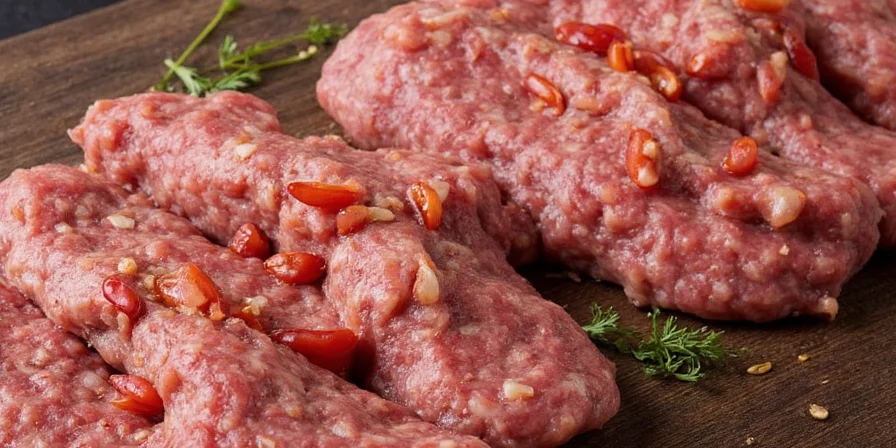Use exactly 1.5% salt by meat weight (15g per 1kg) as your foundational ratio—this precise measurement ensures perfect flavor enhancement and protein binding without excessive saltiness. This guide delivers immediately actionable sausage seasoning techniques backed by culinary science, with quick-reference spice ratios for 5 popular styles, critical mistake avoidance, and step-by-step mixing instructions used by professional butchers. Skip the guesswork and achieve consistently flavorful results on your first attempt.
Essential Sausage Seasoning Ratios at a Glance
| Sausage Type | Salt (1.5%) | Core Spices | Special Notes |
|---|---|---|---|
| Basic Pork | 15g/kg | Black pepper, garlic powder, paprika | Add 1 tsp vinegar per kg for brightness |
| Italian | 15g/kg | Fennel seeds (10g), red pepper flakes (3g) | Crush fennel seeds for better distribution |
| Breakfast | 15g/kg | Sage (8g), thyme (3g), brown sugar (5g) | Use dried sage, not fresh |
| Chorizo | 15g/kg | Smoked paprika (12g), cumin (6g), garlic (5g) | Add 2% vinegar after mixing |
| Bratwurst | 15g/kg | Marjoram (5g), nutmeg (1g), caraway (3g) | Nutmeg must be freshly grated |
5-Step Sausage Seasoning Method Used by Professionals
- Weigh salt precisely at 1.5% of meat weight—volume measurements fail due to varying grind sizes (e.g., 15g salt per 1kg meat)
- Mix dry spices thoroughly before adding to meat—prevents clumping and ensures even distribution
- Test fry a small patty first—cook 30g sample to verify flavor balance before committing entire batch
- Mix until "sticky" (3-5 minutes)—indicates protein activation for proper binding without overworking
- Add acidic components last—incorporate vinegar or citrus after initial mixing to preserve texture

Avoid These 3 Critical Sausage Seasoning Mistakes
- Inaccurate salt measurement: Never use teaspoons—always weigh salt (1.5% of meat weight). A teaspoon of fine vs. coarse salt varies by 30% in actual salt content.
- Adding acid too early: Vinegar or citrus added during initial mixing denatures proteins prematurely, causing mushy texture. Add after primary mixing is complete.
- Using stale spices: Ground spices lose potency after 6 months. Test by rubbing between fingers—if aroma is weak, replace immediately.
Why 1.5% Salt is Non-Negotiable in Sausage Making
This precise ratio isn't arbitrary—it's the scientific sweet spot where:
- Salt dissolves muscle proteins to create proper binding (below 1.2%, sausages crumble)
- Flavor enhancement peaks without creating saltiness (above 1.8%, flavors become one-dimensional)
- Food safety is maintained (salt concentration inhibits bacterial growth)
Professional butchers use this exact percentage across all meat types—adjusting only for added liquid ingredients like grated apples or wine.

Spice Pairing Science: What Works (and What Doesn't)
| Primary Spice | Proven Combinations | Problem Pairings |
|---|---|---|
| Fennel | Oregano + lemon zest + chili (Italian balance) | Heavy cinnamon + cardamom (overpowers) |
| Paprika | Garlic + onion + smoked salt (authentic depth) | Strong mint + basil (clashes) |
| Cumin | Coriander + chili + lime (complex warmth) | Delicate herbs like dill (muted) |
Cultural Context: Why Traditional Spice Blends Work
Regional combinations evolved through practical necessity:
- Italian fennel dominance: Mediterranean climate favored fennel growth while its natural antibacterial properties aided preservation
- German bratwurst marjoram: Central European herb provided necessary warmth in cold climates while balancing fatty meats
- Chorizo's smoked paprika: Iberian curing traditions developed this spice to combat humidity during drying processes
Advanced Technique: Creating Custom Blends
- Start with 1.5% salt as your base
- Add 2-3% total spice weight (e.g., 20-30g per 1kg meat)
- Follow the 70-20-10 rule: 70% primary flavor (paprika/sage), 20% supporting (pepper/thyme), 10% accent (cayenne/lemon zest)
- Always include 0.5-1% acid component (vinegar/citrus) added last

Storage Guidelines for Seasoned Sausage
- Fresh consumption: Use within 48 hours refrigerated at 40°F (4°C) or below
- Freezing: Vacuum-seal and freeze for 2-3 months—thaw overnight in refrigerator
- Drying/curing: Maintain 55°F (13°C) and 75% humidity for traditional preservation

Frequently Asked Questions About Sausage Seasoning
How much salt should I use when seasoning sausage?
Aim for exactly 1.5% salt by the weight of your meat. For example, use 15 grams of salt per 1 kilogram of meat. This precise ratio ensures optimal flavor enhancement and protein binding without excessive saltiness.
Can I substitute fresh herbs for dried spices in sausage?
Fresh herbs work but require adjustments: use triple the volume of fresh herbs compared to dried, and reduce other liquids by 10% to compensate for added moisture. Finely mince herbs to prevent uneven distribution.
Why must I test-fry a seasoning sample before making the full batch?
Cooking a small patty reveals how flavors meld when heated—raw mixtures taste different than cooked results. This step catches imbalances early, saving costly ingredients and ensuring consistent quality in your final product.
How long can I store homemade sausage safely?
Refrigerate fresh sausage for up to 48 hours. For longer storage, freeze in airtight vacuum-sealed bags for 2-3 months. Thaw overnight in the refrigerator—never at room temperature—to maintain food safety.











 浙公网安备
33010002000092号
浙公网安备
33010002000092号 浙B2-20120091-4
浙B2-20120091-4